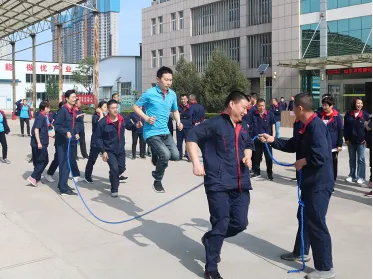Climbing Ropes—Safety, Innovation, and Sustainability. Made in Germany
One of your rope’s most important properties is its balanced elongation. If you fall on the rope, its dynamic design absorbs the fall energy, reducing the impact force, i.e. the energy that acts on your body. In addition, ropes should be compact, abrasion resistant, durable, and supple. With the help of our specially developed braiding technologies and finishes, we constantly tweak these properties and give our ropes additional useful features depending on their intended use, such as a permanent center marking (Color Tec, Duo Tec), a change to the rope’s feel at its ends (Touch Tec), or a special sheath finish for indoor ropes (Sports Braid). After all, our inquisitiveness and passion for mountain sports continually drive us to take on challenges and develop new solutions. It is with good reason that both one of the thinnest single ropes in the world and, as a recent development, the first rope with aramid in the sheath for increased cut resistance come from our rope factory.
Want to find out more about how ropes are created, what is behind our technologies, and what else there is to know about ropes?
How WWII Led to the Climbing Ropes We Use Today
Rope was used by climbers long before hardware was developed, but it was a simple and typically made of animal or plant fibers that were either woven by hand or spun using a Cordelier.
Ropes made by hand meant that uniformity was hard to achieve, plus they had low strength to weight ratio, poor durability, were stiff and had no stretch. They were spiral-braided, which made them strong but hard to manage. They would twist and often made situations dangerous.
The mountaineer G.D. Abraham wrote in 1916: “The parting of a rope to which a climbing path is tied is a frequent accompaniment of an accident. Yet this generally means the leader has fallen, and but for the breakage of the rope the rest of the party must have been dragged down.”
Prior to WWII, ropes gradually became safer. DuPont Chemical Company’s invented nylon in 1935 and it was first used in climbing ropes in America in the early 1940s. Militaries started to use nylon ropes in WWII, and they were introduced to Europe in the mid to late 1940s.
The nylon ropes were more elastic, aiding in fall protection. Machines evolved to allow for tighter, more consistent weaves and stronger ropes.
It all changed in 1953, when the German company Edelrid created the kernmantle design, which placed a strong synthetic rope core within a braided nylon sheath. They increased elasticity and strength, and solved issues with untwisting and rope wear.
The sheath minimized the problem of rope wear, as well as adding improved handling and an intrinsic ability to absorb less water. As ropes rubbed on rocks and climbing gear, the sheath protected the inner core.
The kernmantle rope became an industry standard.
In 1964, Edelrid and Mammut developed dynamic ropes capable of withstanding multiple falls; they became the forerunner of the modern dynamic climbing rope.
Remembrance Day 2020
Remembrance Day is a memorial day observed in Canada and many other countries since the end of the First World War to remember the members of their armed forces who have died in the line of duty.
It’s observed on Nov. 11 to recall the end of hostilities of First World War on that date in 1918. Hostilities formally ended at the 11th hour of the 11th day of the 11th month.
The First World War officially ended with the signing of the Treaty of Versailles on June 28, 1919.
The federal department of Veterans Affairs Canada states that the date is of “remembrance for the men and women who have served, and continue to serve our country during times of war, conflict and peace”; particularly the First and Second World Wars, the Korean War, and all conflicts since then in which members of the Canadian Armed Forces have participated.
Climbing Ropes: Different Types Explained
This article is part of the book - Trad Climbing Basics.
Your rope is the main part of the climbing system. Climbing ropes connect you, via your harness, to the gear in the wall or rock and to your climbing partner.
Climbing ropes are available in a variety of lengths, types and diameters. There are made of two parts; an inner core and an outer sheath.
Single Climbing Ropes
Most beginners start with a single rope. They are thick, durable and easy to belay with. Single ropes are marked with a '1' symbol at the end of the rope. A 60m length with a diameter of between 9.4 – 10.2mm will suit most beginners and last well into your climbing career.
Uses:
- Gym climbing
- Sport climbing
- Top roping
- Less complex trad
Half Ropes
Many trad climbers use half ropes (also known as double ropes) instead of a single rope to help reduce rope drag on wandering routes. They also double the length of the abseil you can make - essential for epic retreats! Safety is increased on complicated terrain where there are sharp edges that risk cutting the rope. If one rope is cut, you still have the other to catch you.
Half ropes need to be used as a pair - climbing with just one isn't safe. Half ropes are marked by a ½ symbol. 60m ropes will be great for most trad routes. When buying half ropes, make sure the colours are very different. Ideally, you will be able to tell them apart in the dark.
Uses:
- Trad climbing
- Alpine climbing
Twin Ropes
Twin ropes are designed to be clipped together into the same carabiners as you climb. It's important not to get these confused with half ropes; twin ropes cannot be clipped to gear individually.
Uses:
- Ice and mixed climbing
Static Climbing Ropes
Static ropes have very little stretch, so they cannot absorb the force of a fall like other ropes. They are mainly used as a 'fixed' rope to ascend or descend. They are usually marked with a EN1891 code. Never lead climb on a static rope!
Things To Consider When Buying a Climbing Rope
Number of Falls
Every climbing rope is rated for a certain number of falls. This is the number of falls using a specific test which indicates how many falls a rope can take before it breaks. Every UIAA certified rope is tested far more severely than you are likely to experience when climbing, so you don’t need to retire your rope just because it’s rated to six falls and you’ve taken seven.
In real climbing situations, a rope will withstand hundreds of falls. They don’t fail unless they run over a sharp edge of rock, which cuts it, or if they have been stored amongst sharp objects or acidic chemicals such as bleach or leaking batteries. They do, however, wear out over time, especially if you take a lot of falls.
Maximum Impact Force
Ropes stretch to absorb energy. The more energy a rope can absorb, the lower the force on your protection.
This isn’t much of a concern for sport climbing, where protection is always bomber bolts. However, for trad climbing, a rope with a low impact force will generate less force on your gear, making it more likely to hold the fall. Lower impact forces are better.
After a fall, let your rope “rest” for five minutes to recover its elasticity. If you get straight back on the rock and then fall immediately, the impact forces will be much higher.
Dry Treatment
Some climbing ropes are made with a special dry-treatment which helps to prevent water being absorbed into them. This means they will be safer in wet conditions then an untreated rope.
The treatment also helps to stop dirt and sand getting into the rope's fibers, which means the rope will run across the rock and through carabiners with less friction than if it was untreated. It's worth the extra cost for a dry treated rope if you plan on climbing in wet/snowy environments.
Diameter
Climbing ropes come in many different diameters. Basically, thinner ropes are lighter and thicker ropes are more durable. Be aware that the diameter of your rope may affect which belay devices you can use it with. Some devices are not compatible with very thin or very thick ropes.
Single rated ropes can be as thin as 8.5mm, making them great for alpine routes. Skinny ropes are safe – they pass the UIAA lab tests. But at the crag, they are more susceptible to abrasion on rough rock or being cut over a sharp edge.
For high-use situations (e.g: big walling, top-roping or working a sport route) a thicker, more durable rope is much better. Your rope is your most critical piece of gear – it’s better to carry a bit more weight than to skimp on safety.
Middle Markers
Most ropes have some kind of mark on their sheath to identify the middle. This is useful in many situations such as gauging how much rope a leader has left, or when setting up an abseil where you need the rope to be perfectly centered at the anchor. Some ropes even have a different colour or pattern on each half to identify the middle.
Remember that if you shorten your rope (such as to remove a frayed end), the middle marker will no longer be correct.
How To Extend Your Climbing Rope's Lifespan
- Keep it out of the dirt. Grains of rock and sand can cut tiny fibres inside the rope.
- Keep your rope away from sharp edges and loose rock by extending your gear.
- Wash your rope occasionally in lukewarm water and allow it to dry in the shade. Prolonged UV light can damage your rope just like it can damage your skin.
- Store your neatly coiled rope in a cool, dry place out of direct sunlight and away from acidic chemicals.
- Only use it for climbing.
How To Inspect Your Climbing Rope
You should check your rope for damage frequently. Starting at one end, feed the rope through your hands, looking and feeling for non-uniform sections. Things to look out for:
- Cuts
- Burns
- Flat or soft spots
- Sheath bunching up over the core
A slightly fuzzy sheath isn’t a problem. However, severe fuzzing may make a rope unsafe. As a general rule, if you can see a rope’s inner core, the sheath has worn too thin and you should retire the rope.
If your rope is damaged, it should be retired. Make a nice rug out of it, or use it as a washing line.










